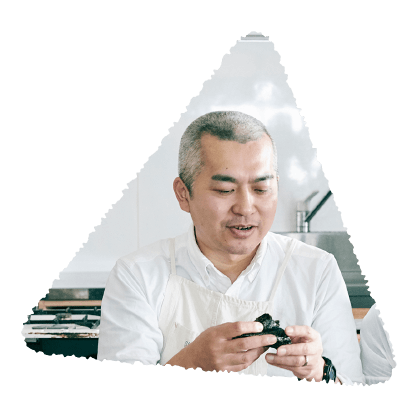 ごはんは深い?
ごはんは深い? Rice is Deep?
Rice is Deep?
ごはんって深いなぁと思うのは、僕の土鍋にしても、「やっぱり、ふっくらやわらかに炊きたい!」というところに気持ちが戻る気もしていて。そういう振り幅を楽しめるのって、日本っていいなぁと思うんです。
The reason why I thought the rice is deep is that, as for my Do-nabe, I feel like changing my mind back to the softer rice. Spoilt for choice, I like Japan.
わかります。ごはん同盟もいろんな時期がありましたから。
I understand. Gohan Doumei has had such times.
総重量法にハマってた時期とかね。
There were times when we were hooked
on the gross weight method.
なんですか、総重量法って?
Gross weight method? What is that?
お米を研いで、お米の量を計って、水を足してまた計って……とか細かく炊飯を分析してたんです。
Such a careful analysis of the rice -- wash and measure the volume of rice. Add water and measure again.
でも、計算するのがめんどくさくなり(笑)。
Then, we felt annoyed about all the calculations (laughter).
結局、おいしく炊ければいいかってね。
In the end, everything is a taste.
おいしく炊ける基本はどこにあるんだろうと思って、
「1合150g、水200cc」というところに落ち着きました。
We end up deciding "150g of the rice, 200cc of water per one person" for the basis of cooking a perfect rice.
研いでいる時に米は水を吸いますよね? それはどう考えるんですか?
If you wash the rice, it absorbs water, and how can you measure the exact amount?
無視してます。
It's impossible.
(笑)。
(laughter)
昔は気にしてたんですけどね。それこそ、総重量法時代とか。
Before, like the Gross Weight Method Ages, we did spend our time and care in doing that work.
なんだよ、「時代」って。そこまでおおげさじゃなかったでしょ(笑)。
The Gross Weight Method Ages? Not to that extent, I think (laughter).

あれは?
研いだお米をいったん冷蔵庫に入れて
冷やしておく時代?
How about the Storing the Washed Rice
in the Refrigerator Ages?
あれはね、時代じゃなくて、私たちの定番! 本当におすすめだから。
That's not the ages! It's very recommendable!
どんな炊き方なんですか?
How about that method?
そもそも、お米って、常温もしくは冷水で研ぐのが基本ですよね。お湯で研ぐと、アミラーゼという酵素が働いてでんぷんが糖に分解されてしまって、お米の旨味が逃げてしまうので。で、さらに冷蔵庫に入れて2時間ほど浸水させておくと、これがおいしく炊けるんです。
Washing the rice with water at room temperature or cold water is usually recommended. If you rinse with hot water, amylase works and starts to break down the starch, so that the deliciousness diminishes. Therefore, store the rice, soaked for about two hours in water, in refrigerator can make it more delicious.
なんでですか?
But why?
えっとね……理由は忘れた。
Um... I forgot.
(笑)。
(laughter)
あれなのかな。ごはん同盟の羽釜の場合、沸騰するまでに10分の時間をかけてるでしょ。その行程の時間を冷水からだとじっくりとれるのがいいのかな?
Let me guess. In the case of the Hagama for Gohan Doumei, it takes about 8-10 minutes until boiling. I guess you can increase this time with cold water.
そうそうそうそう! 沸騰までの時間を長くとれると安定するから、冷たい状態から炊いたほうがおいしいというのを、いま思い出しました!
That's right! I just remembered, with a longer gap of time, you can cook the rice more deliciously.
バルミューダの実験でもそうでした。炊き始めの40度から50度の状態がちょっと長めにとれるとおいしくなるみたいで。あれはどうですか? 炊き方じゃないんですけど、お米選びってみなさんはどうされています?
BALMUDA's test also revealed that a longer time-consuming for starting to cook at 40-50 degrees makes the rice more delicious. By the way, what do you all think of selecting the rice?
少ない量を買う、ですね。でも実家が農家なので米が大量に届くんです。毎回30kgだっけ?
We prefer to buy moderate amount, about 30kg? My hometown, a farm family, delivers the rice for us.
そう、30kg。でも、イベントが続くとすごい量を消費するので、1ヶ月に2回送ってもらって60kgとか。
It's 30kg. Yet, for some special occasions, we need much more rice for holding events, so they send us two times: 60kg.
すごいですね! さきほどの少ない量をというのは、なにか理由があるんですか?
Great. Do you have any reason for that?
匂いです。あんまり置いておくと、ぬかが取れているとはいえ臭くなってくるから。
Smell. If you leave the rice too long, it smells bad.
玄米はいいんですけどね。精米したお米って空気に触れると劣化が始まるんです。だから、ごはん同盟としては、お米の回転率がよくないご家庭には米びつ保管NGを推奨しています。ジップロックなどの密閉袋で、空気に触れないようにして、冷蔵庫の野菜室などで保管するのがおすすめです。
Except for brown rice. The rice begins to age when it's exposed to the air. Thus, we don't recommend storing in the rice bin to those who take much time to eat the rice. Rather, refrigerate it in sealed containers, such as a zip lock bag.
なるほど。山田さんの場合は?
I see. How about you, Yamada?
僕も少量派で2kgぐらいで買います。でも、僕の場合はごはん同盟さんのようなちゃんとした理由じゃなくて、種類の違うお米をたくさん食べたいからっていう。
I also buy a small amount of the rice, like about 2kg. As for me, however, I don't have the right reason for doing this, but it's because I'm interested in buying various types of the rice.
(笑)。
(laughter)
最近、気になる銘柄とかあります?
Do you have any particular brand that you prefer?
ありますあります。山形の「つや姫」がおいしかった!
Yes, "Tsuya-Hime" from Yamagata.
「つや姫」は評判がいいね。女性の評判がとくにいいと思う。
Tsuya-Hime has a good reputation, especially for females.
私たちも試作でいろいろ試したんですけど、個人的には島根の「つや姫」がおいしかったです。
We tested many products as well, but in my opinion, I prefer "Tsuya-Hime" from Shimane.
そうそう。地域的にも、日本海側の島根や鳥取のお米がきてる気がする。
From the perspective of the region, I think the rice from the areas around the Sea of Japan, such as Shimane or Tottori, is of good quality.
きてるきてる。すっごくいい評判聞くもん。
So true. They have an excellent reputation.
ね〜。奥出雲(島根県)で撮影したんやけど、仁多町の「仁多米」っていうのがめっちゃおいしいねんって!
I shot in Okuizumo, Shimane the other day, and heard that Nita rice from Nita is really delicious.
うん。読者のためにフォローさせていただくと、いま話してくれた衛藤さんは、カメラマンでですね、旅とごはんをこよなく愛する関西人です。まぁ、写真じゃなくて座談会という意味においては、完全に部外者の乱入でしたけど。
Yes. For the reader's information, Eto, a photographer, is from Kansai, who is fond of traveling and eating. She just joined in our conversation.
(笑)。
(laughter)















